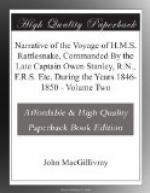I was some time before I could find the remains of Wall and Niblet, who were the last men that died, and had not been buried, the survivors being too weak. I placed myself at the camp, and looked about for the likeliest place to which a corpse would be taken under the circumstances. I went down into a small gully, about sixty yards from the camp; under some small bushes, in about two feet of water, I found their bones, two skulls and some of the larger bones, the smaller ones having most probably been washed away by the flood; the bones were all carefully collected and taken on board. From the position in which these bones were found, agreeing with the description given me by Mr. Carron, I feel confident they are the remains of Wall and Niblet.
I was rather surprised to find some cabbage-palm trees growing in the vicinity of the camp; the tops are very nutritious, and would be very desirable for men in a starving state, had they been aware of it. I picked up part of a key belonging to a chronometer. After having a good look round, we returned to the boats, all tired, from our drenching and wading through so much mud and water, and we unfortunately had no provisions of any kind, and had eaten nothing all day. When we pulled to the entrance of the river it was low-water, and there was a bank dry outside of us for upwards of half a mile; we had no alternative but to wait until the tide flowed. At half past three P.M., got on board, hoisted the boat in, and prepared to start in the morning.
Friday, May 4.
At daylight, weighed, with a light breeze from the southward; steered to give Fair Cape a berth. I observed the entrance of a large river at the north end of Weymouth Bay. At half-past ten A.M., passed Piper’s Islands, and steered for Young Island; could not make it out for some time, when we did see it, found it only a small reef above water, not worthy the name of an island; such a misnomer is likely to mislead; hauled up for the reef M. At noon, abreast of Haggerstone Island, steered to give Sir Everard Home’s Isles a berth; saw natives on Cape Grenville; hauled in for Sunday Island; the wind light from the eastward; passed Thorpe Point, and hauled in for Round Point. At five P.M., anchored in six fathoms, mud. Bearings at anchor, North Sand Hill, D (conical hill) South-East 1/2 East; South Wind Hillock (a saddle hill) South 3/4 East; the remarkable sand patch, South-West 1/2 West; Jackey’s Pudding-pan Hill, West 1/4 North. Got the whaleboat and crew ready to start at daylight for Shelburne Bay.




